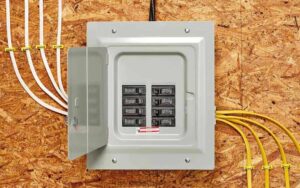The electrical panel is a crucial component of any modern home’s electrical system. It regulates the electricity entering from the main power source and distributes it throughout the house via circuit breakers. However, for new homeowners or first-time buyers, the electrical panel might seem unfamiliar, and even locating it for the first time can be a challenge. Whether you’re building a new home or upgrading an old breaker panel, understanding the basic placement requirements and regulations is essential.
Proper placement of the electrical panel is not just about convenience—it must comply with building codes, wiring standards, and safety regulations set by local authorities. These guidelines help ensure the panel is both accessible and secure. In this guide, we will explore where electrical panels are commonly installed, the regulations governing their placement, and key factors to consider when determining the best location.
The placement of electrical panels varies depending on the home’s layout. In single-family homes, panels are typically located outside the house, in the garage, or in a utility room. In apartment buildings, they are often found indoors, commonly in the kitchen, hallway, or bathroom area.
The electrical panel itself is a rectangular metal box, usually mounted on a wall, with a cover that blends into the surrounding surface. Inside, you’ll find multiple switches or black plastic pieces—these are circuit breakers. Depending on the panel’s size, there could be anywhere from 10 to 50 breakers. Each breaker controls the electricity flowing to a specific part of the house and will trip when an electrical issue occurs, cutting off power to prevent damage or hazards.

Before installing or relocating an electrical panel, it must comply with regulations set by the National Electrical Code (NEC) and Occupational Safety and Health Administration (OSHA). These codes ensure safety and accessibility.
Additionally, OSHA mandates that:

If you’re unsure where to place an electrical panel, following these fundamental guidelines can help:
The panel should be easy to access for maintenance and emergencies. It must have at least 3 feet of clearance in front and be located in a spacious, walkable area. Avoid crawl spaces or tight corners.
To prevent overheating, panels should not be placed in enclosed spaces with limited airflow. Proper ventilation extends the lifespan and efficiency of electrical components.
The NEC recommends that the topmost circuit breaker should not be higher than 6 feet 7 inches, ensuring all adults in the household can reach it comfortably.
All household members and emergency personnel should have immediate access to the electrical panel. Do not lock the panel or place it behind furniture or decorations that make it difficult to locate.

Taking into account safety, accessibility, and compliance with NEC regulations, here are some of the best locations for installing an electrical panel:
An attached garage is one of the best locations for an electrical panel. It offers plenty of space, making it easier to meet clearance requirements while keeping the panel unobtrusive.
The basement is another ideal option. It provides a hidden yet accessible location while allowing for proper clearance. However, in the event of a power outage, it’s wise to have emergency lighting to navigate safely.
Although not as common, some homes have sufficient space under the stairs to accommodate an electrical panel. However, if the area is too cramped, installation should be avoided.
To ensure the electrical panel remains safe and fully operational, follow these key maintenance and safety tips:
Periodically check the panel for signs of damage, rust, or loose wiring. If you notice any issues, contact a professional electrician immediately.
Clearly label each breaker to indicate which part of the home it controls. This is especially important for quick troubleshooting and emergency situations.
Follow the manufacturer’s installation and maintenance instructions to ensure proper functionality and long-term reliability.
Many homeowners accidentally violate clearance requirements by:
By being mindful of these restrictions, you can maintain compliance and improve the overall safety of your home.
Choosing the right location for your electrical panel is critical for safety, accessibility, and compliance with regulations. While functionality is the priority, many homeowners also prefer an unobtrusive placement that blends well with the home’s design. If the panel is in a visible area, painting the cover to match the wall can help it blend in—though covering it completely is not recommended for safety reasons.
The most important factors when selecting a location include compliance with NEC and OSHA regulations, ease of access for maintenance, and protection from moisture, flammable materials, and physical damage. With careful planning, you can ensure that your home’s electrical panel is installed safely and efficiently.